Disclosure: We may earn commissions if you purchase products after clicking on a link from our site.
Are you thinking of hunting deer with a crossbow this season? Crossbows are becoming more and more popular for hunting deer every year. In this guide, we will teach you everything you need to know about how to hunt deer with a crossbow.
We will discuss the different types of crossbows available, as well as the best ways to use them for hunting deer. So whether you are a beginner or an experienced hunter, this guide has something for everyone! After reading, you will know how to hunt deer with a crossbow.
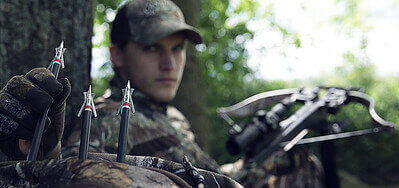
Table of Contents
Types of Crossbows
The two most popular types of crossbows are compound and recurve crossbows. There are other types of crossbows such as reverse draw limbs, pistols, and repeating or automatic crossbows.
1. Compound Crossbows
Compound crossbows are a sophisticated type of crossbow renowned for their power, accuracy, and compact design. Unlike traditional recurve crossbows, compound crossbows feature a system of pulleys and cables known as cams, which enable them to store more energy and produce higher arrow speeds with less effort from the shooter. This design results in greater kinetic energy upon release, making compound crossbows highly effective for hunting and target shooting.
Additionally, compound crossbows often incorporate advanced features such as adjustable stocks, customizable draw weights and lengths, and precision scopes, allowing shooters to tailor the weapon to their preferences and shooting style. With their combination of power, precision, and versatility, compound crossbows have become a popular choice among serious archers and hunters alike. We reviewed the best recurve bows on the market today and you can read it from this link.
2. Recurve Crossbows
Recurve crossbows are a classic and reliable type of crossbow known for their simplicity, durability, and historical significance. These crossbows feature limbs that curve away from the shooter when unstrung, which helps to store and release energy efficiently.
Unlike compound crossbows, recurve crossbows do not incorporate pulleys or cams, relying instead on the inherent flexibility and power of the recurved limbs. While they may not achieve the same arrow speeds as compound crossbows, recurve crossbows are prized for their smooth and consistent shooting experience.
They are also typically lighter and more maneuverable than compound crossbows, making them well-suited for hunting and target shooting in tight quarters. With their straightforward design and timeless appeal, recurve crossbows remain a popular choice among traditionalists and enthusiasts seeking a dependable and authentic crossbow experience.
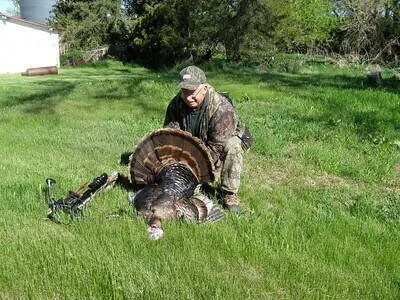
The Parts of A Crossbow
1. Bow
The bow is a fundamental component of a crossbow, serving as the primary mechanism for propelling arrows. In a crossbow, the bow consists of two limbs that are typically made of composite materials such as fiberglass or carbon fiber. These limbs are attached to the front end of the crossbow’s frame, often called the riser or stock.
When the crossbow is cocked, the bow’s limbs are flexed, storing energy that will be transferred to the arrow upon release. The design of the bow, including its draw weight and power stroke, directly influences the speed, accuracy, and kinetic energy of the arrow.
Modern crossbows may feature different types of bows, such as recurve or compound bows, each offering unique advantages in terms of performance and shooting experience. Overall, the bow is a critical element of the crossbow, playing a crucial role in determining its effectiveness for hunting, target shooting, and other applications.
2. String
The string is an essential component of a crossbow, serving as the link between the limbs or cams and the projectile, typically an arrow or bolt. It plays a crucial role in transmitting the stored energy from the limbs or cams to the arrow upon release.
Crossbow strings are typically made from durable materials like synthetic fibers or high-strength polymers, chosen for their ability to withstand the immense forces generated during shooting. The string is attached to the tips of the limbs or cams and is subject to significant tension when the crossbow is cocked.
Proper maintenance and regular inspection of the string are vital to ensure the safe and reliable operation of the crossbow. Over time, strings may wear out or fray, necessitating replacement to maintain optimal performance and accuracy. Additionally, the length and condition of the string can affect the crossbow’s draw weight, power stroke, and overall shooting characteristics. Therefore, understanding the importance of the string and its proper care is essential for crossbow enthusiasts and hunters alike.
3. Trigger
The trigger is a critical component of a crossbow, responsible for releasing the stored energy in the limbs or cams to propel the arrow forward with precision and accuracy. It is typically located within the trigger assembly, which may include a sear, latch, and safety mechanism.
When the shooter applies pressure to the trigger, the sear releases the latch, allowing the string to move forward rapidly, launching the arrow toward the target. The design and quality of the trigger mechanism can significantly impact the crossbow’s performance, including its sensitivity, consistency, and overall shooting experience. A smooth and predictable trigger pull is essential for achieving accurate shots, especially at longer distances or when hunting game animals.
Therefore, crossbow enthusiasts often pay close attention to the trigger characteristics and may customize or upgrade the trigger assembly to suit their preferences and shooting style. Additionally, proper maintenance and periodic inspection of the trigger mechanism are essential to ensure the reliable and safe operation of the crossbow.
4. Arrow
The arrow is a fundamental component of a crossbow, serving as the projectile that is propelled towards the target upon firing. Typically made of lightweight yet durable materials such as carbon fiber or aluminum, arrows are designed to withstand the immense forces generated by the crossbow’s limbs or cams during the shooting process.
Each arrow consists of several key elements, including the shaft, fletching, nock, and arrowhead. The shaft, usually cylindrical in shape, provides the main body of the arrow and determines its stiffness, weight, and overall durability. Fletchings, typically made of plastic or feathers, are attached near the rear of the shaft to stabilize the arrow’s flight and ensure proper aerodynamic performance. The nock, located at the rear end of the arrow, serves as the attachment point to the crossbow’s string, securing the arrow in place before firing.
Finally, the arrowhead, often interchangeable, comes in various shapes and designs depending on the intended use, such as target shooting, hunting, or broadhead deployment. Together, these components work in harmony to deliver accurate and effective shots, making the arrow an indispensable part of the crossbow system.
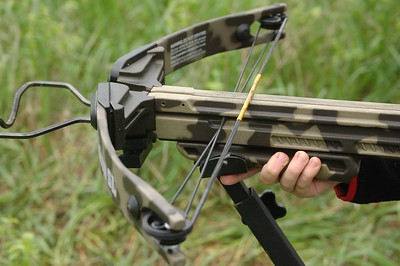
How To Choose The Right Crossbow
There are several factors to consider when choosing a crossbow. There are many brands and models of crossbows on the market today. And not all models are created equal.
1. Size
When choosing a crossbow, size plays a crucial role in determining its usability and performance for the intended purpose. Crossbows come in various sizes, ranging from compact and lightweight models to larger, more powerful options.
The size of a crossbow affects factors such as maneuverability, portability, and accuracy. Smaller crossbows are generally easier to handle and maneuver, making them suitable for hunting in tight spaces or dense vegetation. They are also more convenient for carrying over long distances, such as when hiking to a hunting spot.
On the other hand, larger crossbows typically offer increased power and stability, allowing for greater accuracy and longer effective range. They may be preferred by hunters targeting larger game or shooting from a stationary position, such as a treestand or ground blind. Ultimately, choosing the right size of crossbow depends on individual preferences, hunting conditions, and intended use, with each size offering its own set of advantages and trade-offs.
2. Draw Weight
When selecting a crossbow, one of the critical factors to consider is the draw weight. Draw weight refers to the amount of force required to draw back the string of the crossbow before firing. It directly impacts the speed, power, and accuracy of the arrow.
Crossbows with higher draw weights typically generate greater arrow velocity and kinetic energy, making them suitable for hunting larger game at longer distances. However, they may also be more challenging to cock, especially for individuals with lower strength or physical limitations.
On the other hand, crossbows with lower draw weights are easier to cock and may be more suitable for beginners or individuals seeking a lighter and more maneuverable option. When choosing a crossbow, it’s essential to strike a balance between draw weight and personal capability, ensuring that the selected weight allows for effective and comfortable use while meeting the requirements of the intended hunting or shooting activities.
3. Power Stroke
When considering a crossbow, the power stroke is a crucial factor to take into account. The power stroke refers to the distance the string travels from its resting position to its fully drawn position upon firing. It directly influences the crossbow’s energy output and arrow velocity.
Crossbows with longer power strokes generally generate more kinetic energy, resulting in faster arrow speeds and improved downrange accuracy. This increased energy can enhance the crossbow’s effectiveness for hunting purposes, allowing for deeper penetration and more reliable takedown of game animals.
However, longer power strokes may also necessitate a larger physical size and potentially make the crossbow more challenging to maneuver in tight spaces or dense vegetation. Conversely, crossbows with shorter power strokes may offer greater maneuverability but could sacrifice some power and speed. Therefore, when selecting a crossbow, it’s essential to consider the balance between power stroke length, energy output, and the specific requirements of your hunting or shooting preferences.
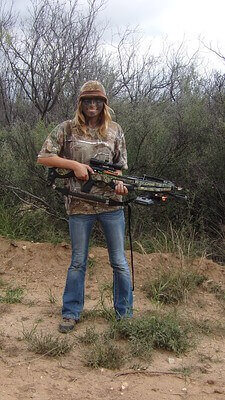
4. Velocity
Velocity is a critical factor to consider when selecting a crossbow. It refers to the speed at which the arrow travels when fired from the crossbow, typically measured in feet per second (fps). Higher velocity crossbows can offer several advantages for hunters and target shooters alike. Increased arrow speed results in flatter trajectories, meaning the arrow will drop less over distance, leading to improved accuracy, especially at longer ranges.
Additionally, higher velocity can enhance the crossbow’s kinetic energy, increasing penetration and improving the likelihood of ethical kills when hunting game animals. However, it’s essential to balance velocity with other factors such as draw weight, power stroke, and noise level, as excessively high speeds may lead to increased noise and vibration, potentially affecting accuracy and shooter comfort.
Ultimately, selecting a crossbow with an appropriate velocity for your intended application and shooting preferences is crucial for achieving optimal performance and success in the field or on the range.
How To Hunt Deer With A Crossbow
1. Choose The Right Crossbow
Choosing the right crossbow is a crucial factor when learning how to hunt deer with a crossbow. Several considerations come into play when selecting the ideal crossbow for deer hunting. First and foremost is the crossbow’s draw weight, which determines the force needed to cock the bow and the speed at which the arrow travels. A crossbow with sufficient draw weight ensures adequate power for a clean and ethical kill.
Additionally, factors such as the crossbow’s size, weight, and balance play a role in comfort and maneuverability while hunting. Opting for a crossbow with a compact and lightweight design can enhance mobility in the field, especially when navigating through dense foliage or confined spaces.
Moreover, considering features like noise level, trigger sensitivity, and scope quality can contribute to accuracy and shot placement, ultimately influencing the success of deer hunting endeavors. Lastly, selecting a crossbow from a reputable manufacturer known for quality craftsmanship and reliable performance can instill confidence and peace of mind during hunts.
By carefully evaluating these factors and choosing a crossbow that aligns with individual preferences and hunting needs, novice hunters can embark on their deer hunting journey with confidence and success.
2. Distance To Deer
The distance to deer is a critical factor to consider when learning how to hunt deer with a crossbow. Unlike firearms, crossbows have a limited effective range, typically ranging from 30 to 60 yards depending on the shooter’s skill level, the specific crossbow model, and environmental conditions.
Hunters need to understand their crossbow’s capabilities and limitations to ensure ethical and humane shots. Getting too close to deer increases the risk of spooking them, resulting in missed opportunities or alerting nearby deer to the hunter’s presence.
On the other hand, attempting shots beyond the crossbow’s effective range can lead to wounded animals and unnecessary suffering. Therefore, novice hunters should focus on practicing shots within their comfort zone and gradually work on extending their effective shooting range as they gain proficiency and confidence with their crossbows.
Additionally, using ground blinds, tree stands, or natural cover to conceal movement and minimize the distance to deer can enhance the chances of successful hunts while maintaining ethical hunting practices.
3. Different Positions
The choice of position is a crucial factor when learning how to hunt deer with a crossbow. Different positions offer varying levels of concealment, stability, and shooting angles, all of which can significantly impact the success of a hunt.
Common positions include standing, kneeling, sitting, and prone. Each position has its advantages and disadvantages depending on the terrain, vegetation, and the hunter’s physical condition. Standing provides better visibility and shooting angles but requires steady balance and may expose the hunter more to detection.
Kneeling offers a lower profile and increased stability but limits visibility and shooting range. Sitting provides comfort and stability for longer waits but may require additional cover for concealment. Prone position offers maximum stability and concealment but limits visibility and shooting angles.
Novice hunters should practice shooting from different positions to determine which works best for their hunting style and the specific conditions of their hunting environment. Additionally, using shooting sticks, bipods, or tree rests can help stabilize shots and increase accuracy from various positions, enhancing the overall hunting experience with a crossbow.
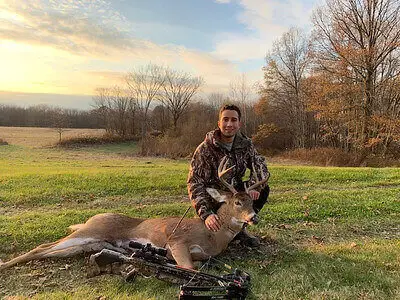
4. Always Be Aware Of Surroundings
Being acutely aware of your surroundings is a critical factor when learning how to hunt deer with a crossbow. Deer hunting demands a high level of situational awareness to effectively anticipate the movement of game animals and adapt to changing environmental conditions.
This includes staying vigilant for signs of deer activity such as tracks, droppings, or rubs, as well as being attuned to the sounds and smells of the forest. Understanding the terrain, wind direction, and potential obstacles is essential for selecting strategic hunting locations and minimizing the risk of detection by wary deer.
Additionally, maintaining awareness of other hunters or outdoor enthusiasts in the vicinity ensures safety and promotes responsible hunting practices. By cultivating a keen sense of awareness, hunters can enhance their success in the field and develop a deeper appreciation for the natural world.
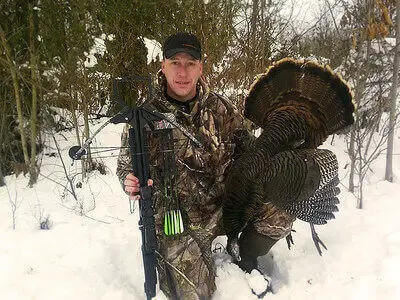
5. Practice, Practice & Practice
Practicing with your crossbow is an indispensable factor when learning how to hunt deer with this weapon. Mastery of your crossbow’s mechanics, aiming techniques, and shot placement is essential for ethical and effective hunting.
Regular practice sessions not only improve accuracy but also instill confidence and familiarity with your equipment, enabling you to make quick and precise shots in real hunting scenarios. By honing your shooting skills under various conditions and distances, you can better anticipate and adapt to the challenges of hunting deer, ultimately increasing your chances of success while minimizing the risk of wounding or injuring game animals.
Moreover, consistent practice fosters a deeper connection between hunter and weapon, fostering a sense of responsibility and respect for the hunt and the natural world.
6. Always Follow Up on A Shot
Following up on a shot is a critical factor when learning how to hunt deer with a crossbow. It involves tracking the wounded animal to ensure a clean and ethical kill. Even with precise shot placement, deer can sometimes run a short distance before succumbing to their injuries.
Therefore, it’s imperative for hunters to immediately assess the shot’s effectiveness and diligently track the animal if necessary. Following blood trails, tracks, and other signs can lead to the successful recovery of the deer, preventing unnecessary suffering and ensuring the utilization of the game meat.
Additionally, following up on a shot cultivates responsible hunting practices, emphasizing the ethical responsibility of hunters to minimize suffering and make the most of the resources harvested from the hunt.
7. Blood Trails
Finding a blood trail and following it is paramount when learning how to hunt deer with a crossbow. A blood trail serves as a vital indicator of the shot’s effectiveness and guides hunters toward the wounded animal’s location.
By carefully examining the blood droplets, splatters, and other signs along the trail, hunters can gain valuable insights into the deer’s condition and trajectory, helping them determine the best course of action for tracking and recovery. Following a blood trail requires patience, keen observation, and persistence, as it may lead through various terrains and obstacles.
Successfully tracing the blood trail not only ensures the ethical retrieval of the deer but also enhances hunters’ tracking skills and understanding of deer behavior. Ultimately, finding and diligently following a blood trail underscores the ethical responsibility and commitment to humane hunting practices, ensuring a clean and respectful harvest.
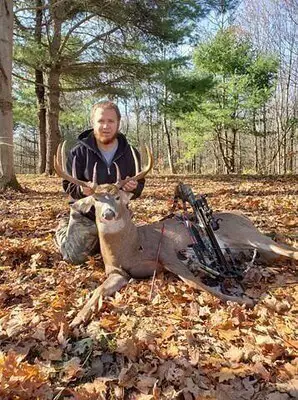
8. Use A Rest
Using a rest for the crossbow when hunting from a treestand is crucial for accuracy and stability, making it an essential factor when learning how to hunt deer with a crossbow. A stable rest provides a solid platform for steadying the crossbow, allowing hunters to maintain proper aim and control over their shots, especially in elevated positions where balance can be challenging.
By supporting the weight of the crossbow and reducing shooter fatigue, a rest enables hunters to focus on their target with increased confidence and precision. Additionally, using a rest minimizes the risk of movement and sway, which could otherwise compromise shot placement and effectiveness.
Whether utilizing a built-in treestand rest or bringing along a portable shooting stick or bipod, incorporating a reliable rest into the hunting setup enhances the hunter’s ability to deliver ethical and humane shots, ultimately increasing the likelihood of a successful harvest. We discussed tips on how to hunt from a tree stand and you can read that article from this link.
9. Take Your Time
Taking your time is a critical factor when learning how to hunt deer with a crossbow. Rushing shots or decisions in the field can lead to missed opportunities or mistakes that could potentially spook game or result in unsafe conditions. By exercising patience and remaining calm, hunters can carefully assess their surroundings, evaluate deer behavior, and wait for the right moment to take a shot. This allows for better shot placement and increases the likelihood of a clean and ethical kill.
Additionally, taking one’s time allows hunters to fully immerse themselves in the hunting experience, appreciating the beauty of nature and the thrill of the chase. Patience is not only a virtue in hunting but also a key component of successful and fulfilling hunts, as it enables hunters to make well-informed decisions and savor every moment of their time afield.
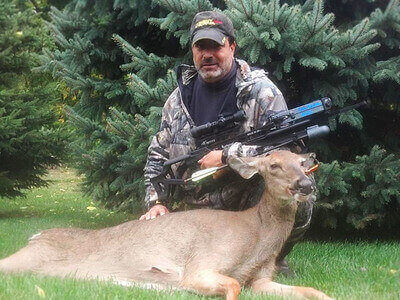
10. Aim For The Kill Zone
Aiming for the kill zone is of paramount importance when learning how to hunt deer with a crossbow. The kill zone, which typically encompasses the vital organs of the deer such as the heart and lungs, is the optimal target area for a quick and ethical kill. By focusing on this precise target, hunters can ensure that their shots are effective and humane, minimizing the suffering of the animal.
Moreover, hitting the kill zone increases the likelihood of a clean kill, reducing the chances of the deer fleeing and becoming lost or suffering unnecessarily. Proper shot placement is essential for ethical hunting practices, and aiming for the kill zone demonstrates respect for the animal and the principles of fair chase. As such, aspiring hunters should prioritize accuracy and precision in their shots, always aiming for the kill zone to ensure a successful and ethical hunt.
Crossbow Accessories
1. Crossbow Scope
The crossbow scope will help you aim accurately. The crossbow scope is an indispensable accessory for any crossbow hunter, offering enhanced accuracy and precision for every shot. Designed specifically for the unique characteristics of crossbows, these scopes provide hunters with a clear and magnified view of their target, allowing for precise aiming and shot placement.
Equipped with reticles tailored to the trajectory of crossbow bolts, these scopes enable hunters to compensate for arrow drops and make accurate long-range shots with confidence.
Additionally, many crossbow scopes feature illuminated reticles and adjustable brightness settings, ensuring optimal visibility in varying lighting conditions. With their durable construction and user-friendly adjustments, crossbow scopes enhance the hunting experience, helping hunters achieve consistent and ethical kills with every shot.
2. Quiver
The quiver holds the arrows. The quiver is an essential accessory for crossbow hunters, providing a convenient and secure way to carry bolts into the field. Typically attached to the crossbow, either directly on the stock or on the limbs, the quiver keeps bolts within easy reach for quick reloading during the hunt.
Quivers come in various designs, including detachable and fixed options, allowing hunters to choose the style that best suits their preferences and hunting style. Some quivers feature quick-detach mechanisms, enabling hunters to remove or attach the quiver swiftly without disrupting their hunt.
Additionally, many quivers offer adjustable features to accommodate different bolt lengths and diameters, ensuring a snug and secure fit for various types of bolts. Overall, the quiver is an indispensable accessory that helps hunters stay organized and prepared for any hunting situation.
3. Release Aid
The release aid is used to draw back the string and release the arrow. The release aid is a vital accessory for crossbow hunters, serving as a crucial link between the hunter and the bowstring. Unlike traditional bows where the archer uses their fingers to release the string, crossbows require a release aid due to the high draw weights and short power stroke.
The release aid ensures consistent and precise releases, enhancing accuracy and shot consistency. It typically consists of a trigger mechanism attached to a wrist strap or handheld device, allowing the hunter to smoothly and effortlessly release the bowstring.
There are various types of release aids available, including wrist strap releases, thumb releases, and back tension releases, each offering different features and benefits to suit individual preferences and shooting styles. Overall, the release aid is an essential accessory for crossbow hunters seeking optimal performance and accuracy in every shot.
4. Broadhead
The broadhead is a type of arrowhead used for hunting. The broadhead is a critical accessory for crossbow hunters, serving as the business end of the arrow responsible for delivering lethal and humane kills. Unlike target points, which are used for practice and target shooting, broadheads are specifically designed for hunting and feature sharp blades that inflict devastating damage upon impact.
Broadheads come in various designs, including fixed-blade and mechanical (expandable) types, each offering distinct advantages and considerations. Fixed-blade broadheads are known for their reliability and durability, with their blades permanently fixed in position, ensuring consistent performance and penetration.
On the other hand, mechanical broadheads deploy their blades upon impact, typically offering a more streamlined flight and potentially larger cutting diameters. Choosing the right broadhead depends on factors such as game species, shot placement preferences, and personal shooting style. Regardless of the type, the broadhead plays a crucial role in the hunting equation, delivering lethal results and maximizing the effectiveness of every shot.
5. Arrows
Arrows are like the ammunition for the crossbow. it is what hits and takes the target down. Arrows are indispensable accessories for crossbow hunters, serving as the ammunition that delivers kinetic energy to the target. Unlike traditional bows, which use longer arrows called bolts, crossbows typically employ shorter, sturdier arrows specifically designed to withstand the higher forces generated by the crossbow’s limbs and string.
These arrows, often referred to as bolts, are typically constructed from materials such as carbon or aluminum, offering a balance of strength, durability, and lightweight properties. Choosing the right arrows for a crossbow involves considerations such as spine stiffness, weight, and length, all of which can impact accuracy, penetration, and overall performance.
Additionally, selecting compatible arrowheads, nocks, and fletchings ensures optimal flight characteristics and terminal performance. Ultimately, arrows are essential components of a crossbow setup, and selecting the appropriate ones is crucial for achieving consistent and ethical hunting results.
The Bottom Line
How to hunt deer with a crossbow has become a popular hunting topic lately. Hunting deer with a crossbow is another way to hunt. Hunting with crossbows has become popular in the last decades. It requires fine-tuning your archery skills but it can be very effective. In this article, we discussed how to use a crossbow to hunt. If you are interested in broadheads, then read the best broadheads for deer.